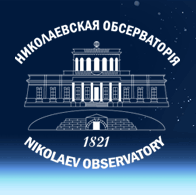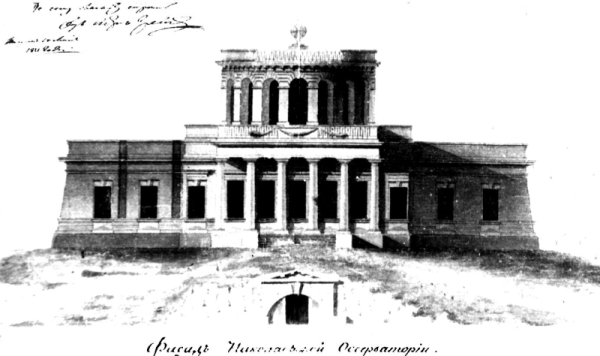| History |
|
2010-11-17 13:18:17
Nikolaev Astronomical Observatory was founded in 1821 by Admiral Aleksey Samuilovich Greig (1775-1845) as a Naval Observatory to ensure the Black Sea Fleet with time, nautical charts and teaching naval officers to utilize astronomical methods of orientation. The top of the Spassky hill, the city of Nikolaev’s highest hill (52M), was chosen as the construction site for the observatory. The designer of the main building project was Fyodor Ivanovich Wunsch (1770-1836), who was also the main architect of the Black Sea Admiralty. Karl Frederick Knorre was appointed to the position of first director on the recommendation of Vasiliy Yakovlevich Struve (1801-1883). In addition to his work in the preparation of naval officers, K. Knorre began the scientific astronomical research. In the history of astronomy he is known as the author of the Berlin Academy of Science’s 5th sheet of the star map, by the help of which the minor planets Astrea and Flora were discovered. K. Knorre held the position of director of the Observatory for 50 years. The second director Ivan Y. Kortatstsi (1837-1903) continued the astronomical research at the Observatory, cataloging the position of stars later named the “Nikolaev Zone”. In the marine period of the observatory, K.H. Knorre and I.E. Kortatstsi carried out hydrographic survey works on the Azov, Black and Marmara Seas. They conducted an inventory of, and more precise identification of geographical coordinates of many control points on these sea maps. The fleet was equipped with precision instruments and perfected methods of determining the time (longitude) and latitude. Until 1911 the Observatory belonged to the Navy Ministry, and from 1912 to 1991 NAO became the southern branch of the Pulkovo Observatory. The main objective of the Observatory at that time was the spread of the Pulkovo absolute star catalogs to the southern sky and the implementation of regular observations of the Sun and Solar system bodies. To equip the new department the Repsold Vertical Circle and the passage instrument (Freiberg-Kondratiev) were moved from Odessa. The Observatory managed to survive and was preserved as a scientific institution during a period of great distress in our society: the First World War, the Bolshevik Revolution and then Civil War. Boris Pavlovich Ostaschenko-Kudryavtsev (1879-1956) was the director at that times. The Renaissance of the Observatory after the ordeal is associated with the name of the fourth director Leonid Ivanovich Semenov (1878-1965), who headed the Observatory in 1923. In 1931, the highly accurate Time Service was created by NAO, which contributed to national and international programs to determine the exact time. In 1935 the observatory was included in the system of institutions of the Academy of Sciences of the USSR as a branch of the Pulkovo. During the Great Patriotic War from August 1941 to March 1944 the observatory was occupied by the Germans. Director L.I. Semenov managed to keep it from serious injury and destruction. In the postwar period Jakov E. Gordon (1912-1978) was appointed to the post of director of the observatory (in 1951). In 1955, the Repsold Meridian Circle was transported to Nikolaev from Pulkovo after reconstruction and a number of upgrades, on which different observational programs were carried out during 40 years. In 1961, the Zonal Astrograph made by the “Carl Zeiss” firm was transfered from Pulkovo to NAO and the history of photographic astrometry has begun. Nikolaev photographic observations of Solar system bodies are among some of the most accurate in the World. In 1957-1969 visual and photographic observation satellites were carried out to determine their orbits. In 70 – 80s, the observatory was the initiator and main administrant of several scientific expeditions for observations upon conditions of Polar night and high mountains in the Caucasus on the West Spitsbergen island. In total, nearly 35 different catalogs were created by NAO with the positions of celestial bodies. In 1978 Rima Timofeevna Fedorova (1934 born) became director of the observatory. Gennady Pinigin (current director, 1943 born) took up the position of director in 1986. In 1992, Nikolaev Astronomical Observatory gained the status of an independent scientific institution, and in 2002 received official status as a Research Institute. Maintaining its scientific traditions, NAO has expanded the research topics in the area of astronomical instrumentation and research of Near-Earth Space. In 1995, the NAO created and brought into action an automatic telescope with a CCD detector - the Axial Meridian Circle (AMC), which in 1999 was included in the Tentative list of objects that make up the national property of Ukraine. After upgrade and an equipping the Zonal astrograph with CCD detector, it was renamed to the Multi-Channel Telescope (MCT). In 2004 the Fast Robotic Telescope (FRT) was put into service. The regular observations of near space objects are conducted on FTR, within the framework of participation in the National Space Program of Ukraine’s monitoring and analysis of Space conditions. In 2009, the first Ukrainian mobile telescope "Mobitel" was created. It consists of four independent mount equiped with modern CCD cameras with control system program in the remote access mode. Currently work on the creation of Nikolaev Virtual Observatory (NikVO) as part of Ukrainian National Virtual Observatory is being conducted.
|

Íàóêîâî-äîñë³äíèé ³íñòèòóò
Ìèêîëà¿âñüêà àñòðîíîì³÷íà îáñåðâàòîð³ÿ
̳í³ñòåðñòâî îñâ³òè ³ íàóêè
Ìèêîëà¿âñüêà àñòðîíîì³÷íà îáñåðâàòîð³ÿ
̳í³ñòåðñòâî îñâ³òè ³ íàóêè

 |
 |
 |
